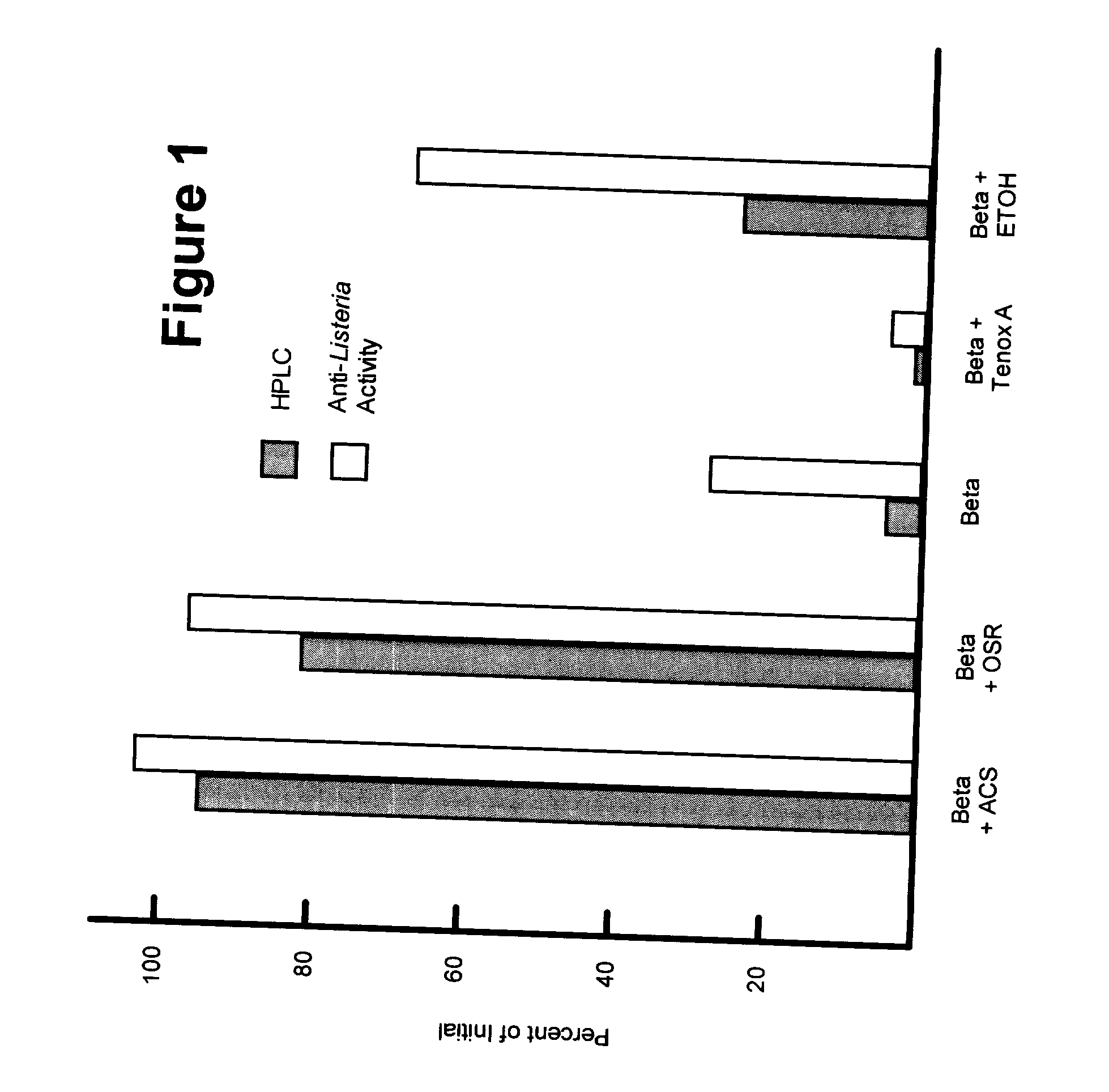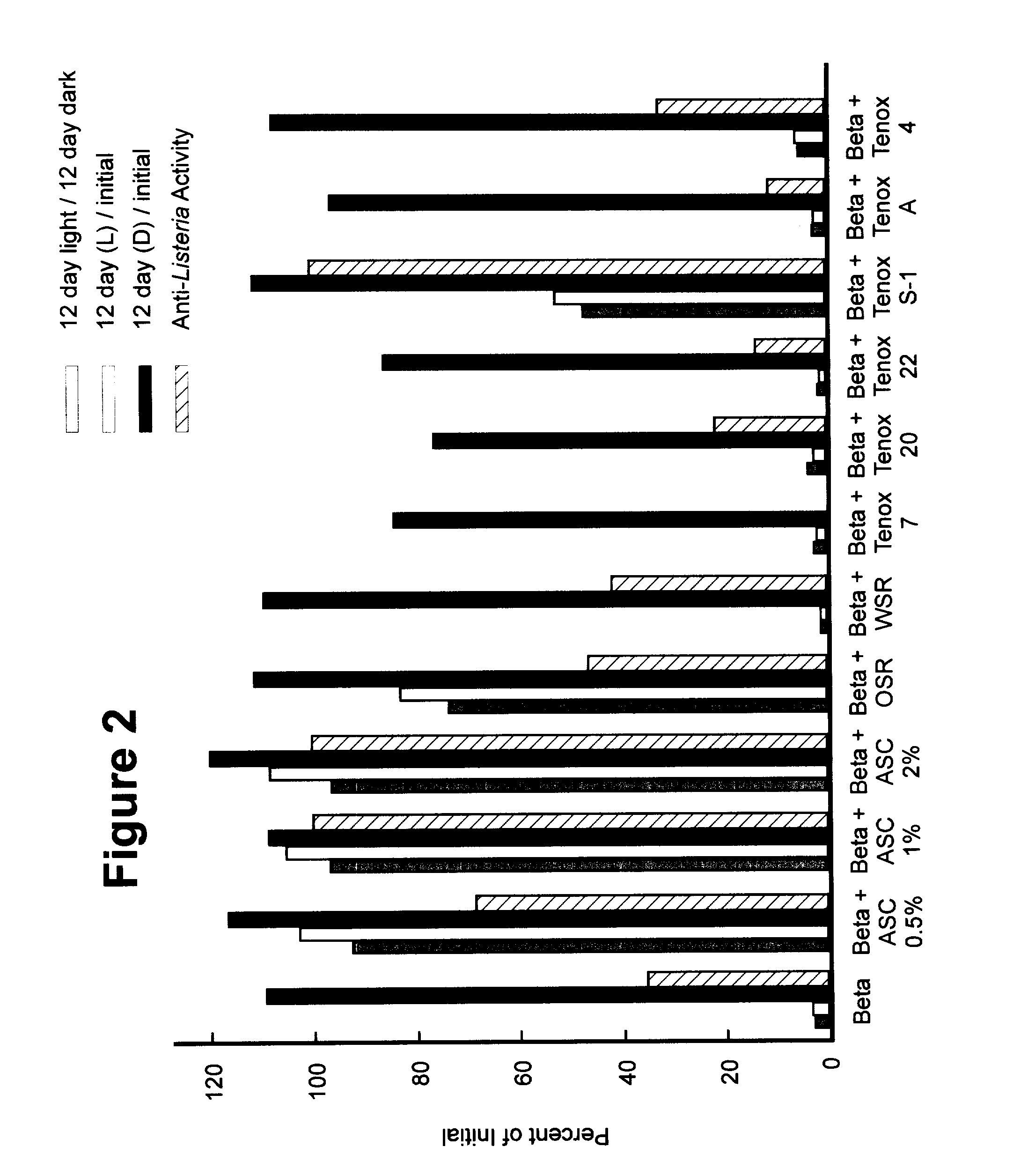Hop beta acid compositions for use in food products
a technology of hop beta acid and composition, which is applied in the field of improved can solve the problems of inability to easily compensate for variations, inability to reach the full potential of variations, and inability to stabilize and/or improve the effect of hop beta acid composition, the effect of increasing the stability of the composition
- Summary
- Abstract
- Description
- Claims
- Application Information
AI Technical Summary
Benefits of technology
Problems solved by technology
Method used
Image
Examples
example 1
[0027] Stock solutions containing 10,000 ppm hop beta acids (Watertown Hops) were prepared by weighing 0.1 gram of beta acids into a vessel and adding 9.9 ml of a carrier (propylene glycol or ethanol). Heating was carried out in a water bath at 150.degree. F., with mixing being carried out with a vortex mixer until the beta acids were dissolved. The stock solution was diluted 1:10 in the desired carrier to provide a 1000 ppm beta acid composition.
[0028] Certain of these beta acid compositions were combined with a 1000 ppm antioxidant component. In these compositions containing antioxidants, the antioxidant was mixed with the hop beta acid and the amount of carrier was reduced by an equal amount. The following antioxidant-containing compositions were prepared: (a) 1000 ppm beta acids with 1000 ppm ascorbic acid in a propylene glycol carrier; (b) 1000 ppm hop beta acids with 1000 ppm OSR Liquid (StabilEnhance #1280) in a propylene glycol carrier; and (c) 1000 ppm hop beta acids with 1...
example 2
[0037] The procedures followed in Example 1 to prepare the beta acids were used to prepare the beta acid solutions shown in Table 1.
1 TABLE 1 Description of Hop Beta Antioxidant Propylene Treatment Acid (g) amount glycol (g) Control 0.1 0 9.9 Ascorbic Acid 0.1 0.005 g 9.8 Ascorbic Acid 0.1 0.1 g 9.8 Ascorbic Acid 0.1 0.2 g 9.7 0SR 0.1 100 .mu.l 9.8 WSR 0.1 100 .mu.l 9.8 Tenox 7 0.1 100 .mu.l 9.8 Tenox 20 0.1 100 .mu.l 9.8 Tenox 22 0.1 100 .mu.l 9.8 Tenox S-1 0.1 100 .mu.l 9.8 Tenox A 0.1 100 .mu.l 9.8 Tenox 4 0.1 100 .mu.l 9.8
[0038] For each treatment, the total solution was 10 mL. In Table I, OSR refers to StabilEnhance OSR liquid #1280, and WSR refers to StabilEnhance WSR liquid #2411.
[0039] The composition of the Tenox antioxidants are listed in Table 2. Except for Tenox 4, all Tenox solutions used propylene glycol as a carrier.
2 Tenox Tenox Tenox Tenox Ingredient Tenox 7 20 22 S-1 A Tenox 4 BHA 28 20 40 20 BHT 20 TBHQ 20 6 Propyl gallate 12 20 Critic Acid 6 10 4 10 8 Glycerol 20...
example 3
[0044] An antimicrobial solution containing about 0.3M lactic acid, about 0.3M potassium ion (in the form of potassium lactate), and about 20,000 ppm hop beta acids in propylene glycol was evaluated in challenge studies with packaged wieners using a six-strain cocktail of L. monocytogenes. Commercially available wieners were placed into pre-formed heat sealable pouches (4 per pouch). A L. monocytogenes culture was inoculated onto the smooth middle surface of the wieners to achieve about 1.times.10.sup.2 CFU / package or about 1.times.10.sup.4 CFU / package, respectively. Antimicrobial solution (1.5 or 2.0 ml) was added to the bottom of the pre-formed pouch and the pouches were vacuum sealed. Samples were held for 24 hours to 7 days at 4.degree. C. and then analyzed for the presence of L. monocytogenes by direct plating onto plate count agar and MOX (Modified Oxford Medium) plates. Colonies producing a black precipitate on the plates were considered positive for L. monocytogenes. Additio...
PUM
 Login to View More
Login to View More Abstract
Description
Claims
Application Information
 Login to View More
Login to View More - R&D
- Intellectual Property
- Life Sciences
- Materials
- Tech Scout
- Unparalleled Data Quality
- Higher Quality Content
- 60% Fewer Hallucinations
Browse by: Latest US Patents, China's latest patents, Technical Efficacy Thesaurus, Application Domain, Technology Topic, Popular Technical Reports.
© 2025 PatSnap. All rights reserved.Legal|Privacy policy|Modern Slavery Act Transparency Statement|Sitemap|About US| Contact US: help@patsnap.com


